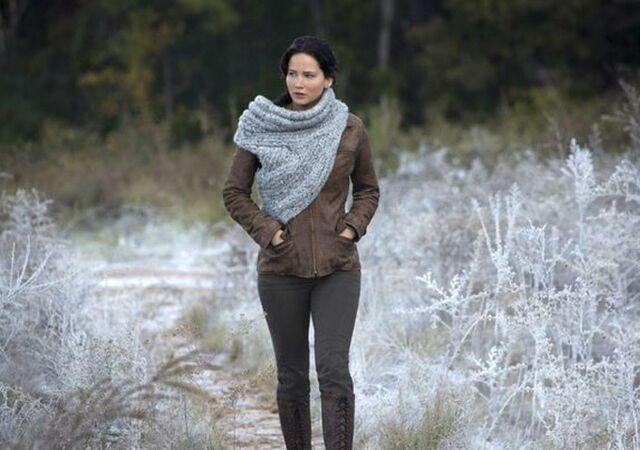Yesterday I discussed in depth why I loved the fashion in the book trilogy The Hunger Games (fashion as rebellion, costumes drive the plot, costume designer main character), and why I was therefore disappointed with the film version of the first book (lame costumes). Today I discuss the second film, Catching Fire, which came out last Thursday, and my love of the movie. I will also discuss the concurrent marketing campaign that took what should have been a mirror to ourselves and put it in a department store dressing room.
I have nothing but praise for Trish Summerville's work on Catching Fire. The District citizens were impoverished looking, wearing natural fibers and animal skins, but the silhouettes were not necessarily of "our" time in fashion. These warmer earth tones and soft fibers contrasted nicely with the stark white manufactured fabrics on the Peacekeepers, terrifying guards sent in by the Capitol to control the general populace.




And the Capitol citizens were brilliant. Huge unwieldy costumes, swaths of bright colors and rich fabrics galore, and the most impractical footwear. Historically, unwieldy fashion has always been reserved for those who can "afford" to mince around on scrunched toes and in giant contraptions designed to work against the body to create an artistic and eye-catching shape, rather than to perform the everyday motions of the poor. Capital fashion, like the high-heeled French bourgeoisie, corseted Victorian English, bound-feet Chinese upper class, and our modern surgery-inspired wealthy fashion, is designed to scream "I don't do manual labor."

Effie Trinket, Katniss's Capitol liaison and resident Miss Manners, wears elaborate uncomfortable ensembles that reflect each season, which was a brilliant way to incorporate the throwaway nature of Capitol fashion trends and do a practical bit of storytelling, showing the long, arduous process of the first year in spotlight after winning the Hunger Games. In both films, the uniforms for the actual Games were portrayed very accurately: simple, practical outfits with manufactured fibers built to withstand extreme heat or cold, but with no creature comforts. This is, after all, a battle to the death.

The portrayal of Cinna's creations in this film are perfection: once again dressing Katniss and Peeta up to look terrifying and angry that they are being forced back into the Games. And then there is The Dress. The wedding gown President Snow forces Katniss to wear in her interview to prove her submissiveness and complicity with the Capital is designed by the ever-crafty Cinna, and has a surprise for the viewing audience. Once she starts spinning, the gorgeous but awkwardly heavy bejeweled wedding gown befitting a princess literally catches fire, turning black and unfolding into wings. For a brief moment, she is the mockingjay, her token pin and a burgeoning symbol of the resistance. This moment is the moment that inexorably links her to the resistance, and ensures her leadership in the full-scale rebellion, and the gown shoulders the responsibility stunningly.


The portrayal of Cinna's creations in this film are perfection: once again dressing Katniss and Peeta up to look terrifying and angry that they are being forced back into the Games. And then there is The Dress. The wedding gown President Snow forces Katniss to wear in her interview to prove her submissiveness and complicity with the Capital is designed by the ever-crafty Cinna, and has a surprise for the viewing audience. Once she starts spinning, the gorgeous but awkwardly heavy bejeweled wedding gown befitting a princess literally catches fire, turning black and unfolding into wings. For a brief moment, she is the mockingjay, her token pin and a burgeoning symbol of the resistance. This moment is the moment that inexorably links her to the resistance, and ensures her leadership in the full-scale rebellion, and the gown shoulders the responsibility stunningly.

It is not difficult, however, to ascertain that the wealthy, insensitive, over-indulgent Capitol citizens, who enjoy their opulent lifestyles on the backs of the impoverished District citizens, are an allegory for the United States and its first-world brethren. We root for Katniss because she is the main character, and the underdog, and just totally badass, but not because we can relate to her. Each of the twelve Districts in the book is dedicated to producing one vital aspect of the Capitol citizenry's cushy lifestyle: coal, lumber, textiles, weaponry, luxury items, etc. The Capitol produces very little and consumes the majority of what is produced in the Districts; for example, in District 12 nearly every citizen is dedicated to work in the coal mines, and yet lights flicker and people freeze to death in winter. What one would hope should come out of the popularity of this series is a sensitivity and sympathy for those in less fortunate circumstances, particularly when we directly benefit from their labor, as in the fashion industry.
We still live in a world in which hundreds of people can die in a factory fire making luxury items they will never own themselves. What I would have loved to see in the marketing for these films is a recognition of this fact through PSAs, public discussion, or publishing supplemental material. Instead, a fashion marketing campaign was run that not only accepted the fact that we are Capitol citizens but embraced it full on, encouraging us to buy "Capitol Couture," to emulate the fictional consumers by becoming them ourselves. Instead of elevating a relevant and sensitive subject to do good in the world, we are left with this lame attempt at "we're not the bad guys, really!" marketing. As a story-telling device, the costumes in Catching Fire were spot on: perfectly framing the opulence of the Capitol vs. the forced poverty of the Districts. But this kind of high fashion escapism is exactly what is wrong with the people we consider ourselves intellectually above in the films. This marketing campaign could have learned from our past and done something interesting and inspired, but instead chose to perpetuate established norms.
















































